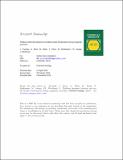Thallium elemental behavior and stable isotope fractionation during magmatic processes
Abstract
Stable thallium (Tl) isotopes are an extremely sensitive tracer for the addition of small amounts of sediments or materials altered at low temperatures to the source(s) of mantle-derived melts. The ability of Tl to trace such materials is due to the large concentration contrast between the mantle (Tl < 2 ng/g) and possible exotic inputs (Tl ~ 100 ng/g to > μg/g), which also often display fractionated Tl isotope compositions. However, the magnitude of Tl isotope fractionation induced by igneous processes alone has not been systematically assessed. Here, two suites of co-genetic magmas, spanning a large range of differentiation, from Hekla, Iceland, and Anatahan, in the Mariana arc, are used to assess the behavior of thallium and its stable isotope variations during magmatic processes. Thallium behaves as a near-perfectly incompatible lithophile element throughout magmatic evolution, mirroring elements such as Rb, Cs, and K. Lavas from Hekla have restricted Cs/Tl ratios and stable Tl isotope compositions, which overlap with mantle estimates. Lavas from subduction-related Anatahan volcano also have a restricted range in Tl isotope composition, which overlaps with Hekla and MORB, demonstrating that fractional crystallisation and partial melting does not fractionate stable Tl isotopes. Subduction environments display variable Cs/Tl, indicating that the subduction process commonly fractionates these two elements. The immunity of thallium stable isotopes to fractionation by magmatic processes coupled with its extreme sensitivity for tracing pelagic sediments, FeMn crusts and low temperature altered oceanic crust highlight its value in elucidating the nature of mantle sources of both oceanic basalts and arc lavas. Critically, meaningful interpretation of thallium isotope compositions need not be restricted to primitive lavas.
Citation
Prytulak , J , Brett , A , Webb , M , Plank , T , Rehkämper , M , Savage , P S & Woodhead , J 2017 , ' Thallium elemental behavior and stable isotope fractionation during magmatic processes ' , Chemical Geology , vol. 448 , pp. 71-83 . https://doi.org/10.1016/j.chemgeo.2016.11.007
Publication
Chemical Geology
Status
Peer reviewed
ISSN
0009-2541Type
Journal article
Description
JP was partly supported by NERC fellowship NE/H01313X/2. AB was supported by a Janet Watson Earth Science and Engineering Departmental PhD studentship and MW was supported in part by an undergraduate research opportunity award from Imperial College London. Trace element analyses were supported from US NSF Grant EAR-1456814 to TP.Collections
Items in the St Andrews Research Repository are protected by copyright, with all rights reserved, unless otherwise indicated.

